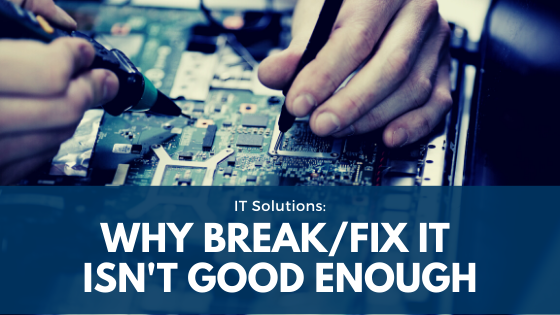With the old break/fix IT model, you would only deal with your IT service provider when things break. As the role of IT evolves, it’s time to rethink break/fix IT solutions.
Why break/fix is obsolete
To understand why this model is antiquated, we have to go back to the 90s and early 2000s, a time when businesses didn’t rely on their digital presence as strongly as they do now.
Businesses ran into IT problems, but operations didn’t come to a halt. Fixing these issues was relatively simple and affordable. In fact, it was common for just one person to run what we call an IT department today.
Nowadays, with 87% of businesses using the cloud for business acceleration, a reliable IT infrastructure is far more important. Plus, IT is more complex and there are more threats now than ever before.
The need for a proactive solution
With the break/fix model, you don’t replace equipment until it stops working. A computer might give you the blue screen of death or an old server might not be compatible with a new update you need to install. That’s when you would replace it.
With this approach, you get the most out of your equipment because you use it for as long as possible. However, the event that triggers the replacement is disruptive and expensive. Replacing a server or another crucial piece of your network results in downtime for your entire organization.
It’s not ideal for users who need a reliable IT infrastructure to be productive. Besides, an hour of server downtime costs $301,000 to $400,000 for 25% of businesses.
There’s no quick fix
Break/fix IT solutions would come in when something stops working and would provide a replacement. But is it really that simple? No. The replacement might not meet your needs a few months down the road.
When upgrading modern IT infrastructures, you’re looking for careful consideration of your unique needs. A team of experts should review your requirements and goals to recommend the tech solution that makes the most sense.
By opting for a managed service provider over a break/fix solution, you get the benefit of a long-term partner who develops a technology roadmap for you. This roadmap anticipates future needs and helps you spend your IT budget on scalable solutions that support growth.
Is break/fix at all cost-effective?
Break/fix can seem more affordable at first. After all, you only spend money when something breaks. However, costs can quickly add up, especially as your hardware ages. The truth is that you have very little control over IT spending. You can’t foresee a major expense like replacing a server until it breaks.
Additionally, break/fix IT providers can charge extra fees linked to overtime or working on holidays. You will have no choice but to pay these fees since you need your network up and running.
With an MSP, you pay a monthly fee, which includes maintenance, repairs, tech support and problem prevention.
Is it in your best interest?
Think about how IT services make their money. With the break/fix model, they make a profit when something breaks. Is it in their best interest to optimize your network and prevent future issues?
An MSP thrives on building long-term partnerships. By helping you adopt new tech solutions that support your growth, an MSP grows along with you.
Ready to leave break/fix IT solutions behind?
If you’re still relying on the break/fix model, it might be time to reconsider. SecureTech is a reliable managed service provider in the San Antonio, TX area. Get in touch with us to learn more about the benefits of leaving break/fix behind.

